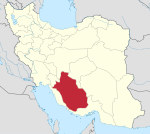Farashband
Farashband
Persian: فراشبند | |
|---|---|
City | |
 The old fire temple | |
| Coordinates: 28°51′42″N 52°05′37″E / 28.86167°N 52.09361°E[1] | |
| Country | Iran |
| Province | Fars |
| County | Farashband |
| District | Central |
| Elevation | 775 m (2,543 ft) |
| Population (2016)[2] | |
• Total | 20,320 |
| Time zone | UTC+3:30 (IRST) |
Farashband (Persian: فراشبند)[a] is a city in the Central District of Farashband County, Fars province, Iran, serving as capital of both the county and the district.[4] The city is at an altitude of 775 metres (2,543 ft).[5]
Demographics
[edit]Population
[edit]At the time of the 2006 National Census, the city's population was 17,142 in 3,762 households.[6] The following census in 2011 counted 18,492 people in 4,700 households.[7] The 2016 census measured the population of the city as 20,320 people in 5,717 households.[2]
Overview
[edit]This section needs additional citations for verification. (September 2023) |
Farashband is one of the Fars province cities which is located 172 km west of Shiraz. It neighbours from the north with Kazeroon, from the west with Booshehr, from the south with Lar and the east with Ghir-Karzin and Firoozabad. Its height above sea level is 750 metres (2,460 ft) and its area is approximately about 59,455 hectares (146,920 acres). The climate is hot and dry, with annual average temperature of 25 °C.
Citrus orchards, especially palm and Ghasb zahedi call into existence some tourism prospects for this region. In addition, the region’s nomads have created a beautiful space and the emergence of the hand-woven like Gabbeh, Glim and Jajim. Language is a mixture of ancient Persian, Lorrish (Bakhtiari-Laky) Mamassani and Kohkilloyehee. But some idioms are different from one village to another. Also the Qashqai language is spoken here, too. Several tribes live in Farashband such as Lorr, Tork and Pars.
Nearly 25,000 nomadics inhabit for 7–8 months in pastures every year. Qashqais include some tribes such as Amale, Shesh bluki, Farsimadan, and Ardkapan. Furthermore, there are different tribes of Lorr like Nobenjani, Ghalesefidi, Bakhtiari, sadat fahluanisarruee and Dashti – the rest of the population are of the Tajik tribe. The city has natural gas resources and its economy is based on agriculture, gardening (palm), and carpet weaving.
Farashband has a history of 1600 years. Monuments left indicate this fact in this city. Despite the great antiquity, due to lack of resources and historical documents, it is considered younger than other cities. People have always believed that the city was created during the reign of Bahram Gur (Sasanian Empire). Monuments with the chahartaq architecture show this fact.
There are several archaeological sites such as:
- Chahar Tagh gangi (four-arched) related to Sassani period
- Farrashband’s bath
- Chahar Tagh naghare khaneh
- ChaharTagh Rahni5-ChaharTagh Gonbad
- wind mill
- goldsmiths Ghallat related to Afsharian period
Most tourism prospects and religious area is consist of Konarmalek four-arched, tol gangi four arched, Zayerhosseini four-arched, Khormayak, Gonbad, Ghanatbagh, Rahni four-arched, Barmefarhad spring, Abpa spring, mountain park, emamzade holy shrine (Agham shahid) shahzade tayyeb holy shrine (zeinalabedin), Shahaziz holy shrine (to Baghi), Seyyed Ahmad holy shrine, Seyyed Mohammad holy shrine, Alibakhsi, Pirgheib, Mohamnad (khaniak), Agha Mohammad (khorab), Amir Shahsavar (dezhgah) and Abbolghasem (Dehram) holy shrines.
According to a 1939 publication of the anthropologist Henry Field, 2,000 Circassians lived in Farashband.[8]
See also
[edit]Notes
[edit]References
[edit]- ^ OpenStreetMap contributors (2 October 2024). "Farashband, Farashband County" (Map). OpenStreetMap (in Persian). Retrieved 2 October 2024.
- ^ a b Census of the Islamic Republic of Iran, 1395 (2016): Fars Province. amar.org.ir (Report) (in Persian). The Statistical Center of Iran. Archived from the original (Excel) on 6 April 2022. Retrieved 19 December 2022.
- ^ Farashband can be found at GEOnet Names Server, at this link, by opening the Advanced Search box, entering "-3062746" in the "Unique Feature Id" form, and clicking on "Search Database".
- ^ Aref, Mohammad Reza (c. 2014) [Approved 13 December 1381]. Approving the following divisional changes and reforms in Fars province. rc.majlis.ir (Report) (in Persian). Ministry of the Interior, Political-Defense Commission of the Government Board. Proposal 1.4.42.99761; Notification 58538/T26118H. Archived from the original on 13 April 2014. Retrieved 8 December 2023 – via Islamic Parliament Research Center.
- ^ Farashband - Falling Rain Genomics
- ^ Census of the Islamic Republic of Iran, 1385 (2006): Fars Province. amar.org.ir (Report) (in Persian). The Statistical Center of Iran. Archived from the original (Excel) on 20 September 2011. Retrieved 25 September 2022.
- ^ Census of the Islamic Republic of Iran, 1390 (2011): Fars Province. irandataportal.syr.edu (Report) (in Persian). The Statistical Center of Iran. Archived from the original (Excel) on 16 January 2023. Retrieved 19 December 2022 – via Iran Data Portal, Syracuse University.
- ^ FIELD, H. (1939). CONTRIBUTIONS TO THE ANTHROPOLOGY OF IRAN. Publications of the Field Museum of Natural History. Anthropological Series, 29(1), p. 209. from http://www.jstor.org/stable/29782234
External links
[edit]- News Abpa Archived 24 March 2020 at the Wayback Machine


